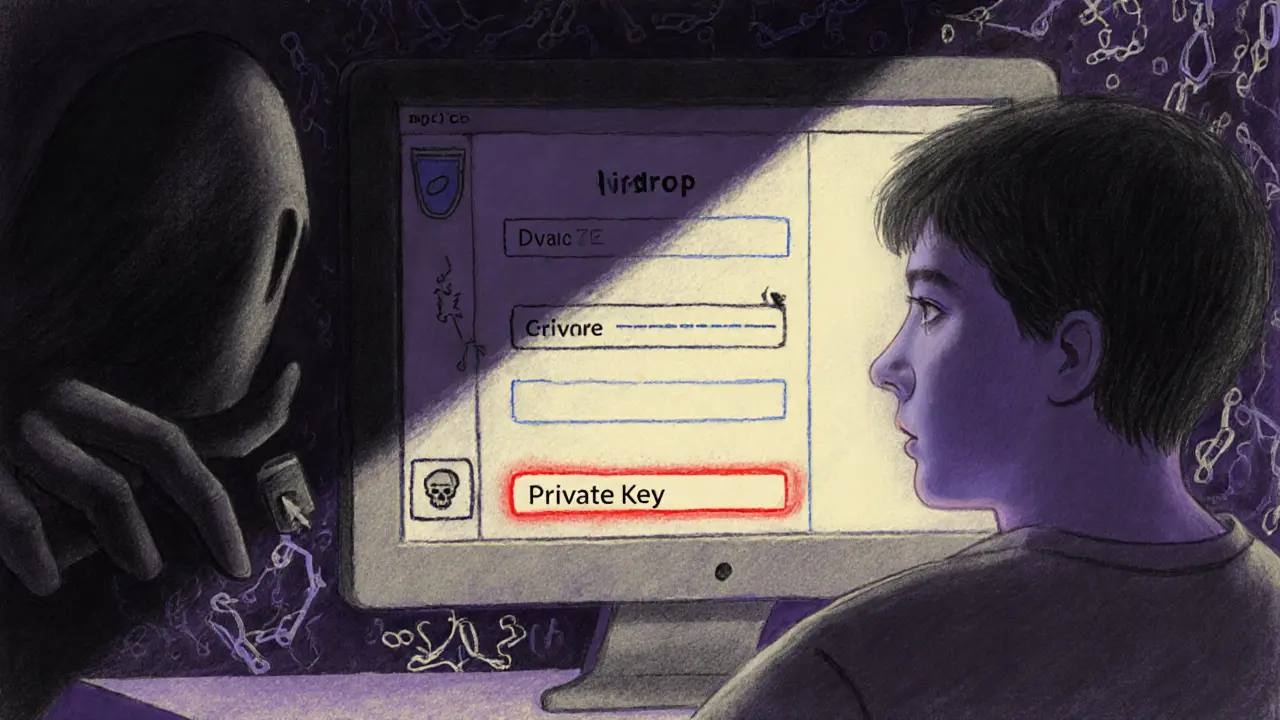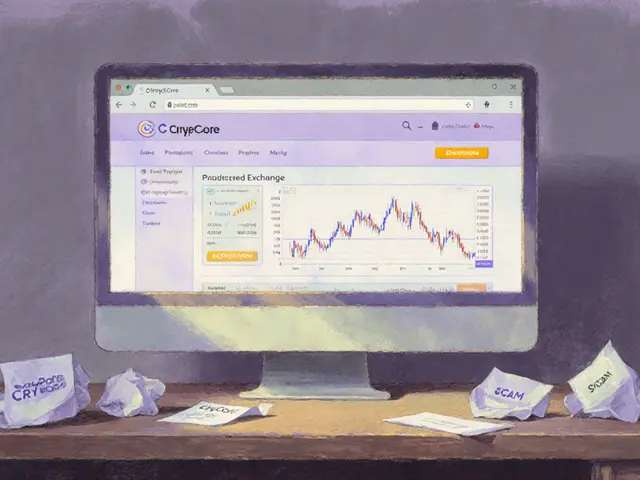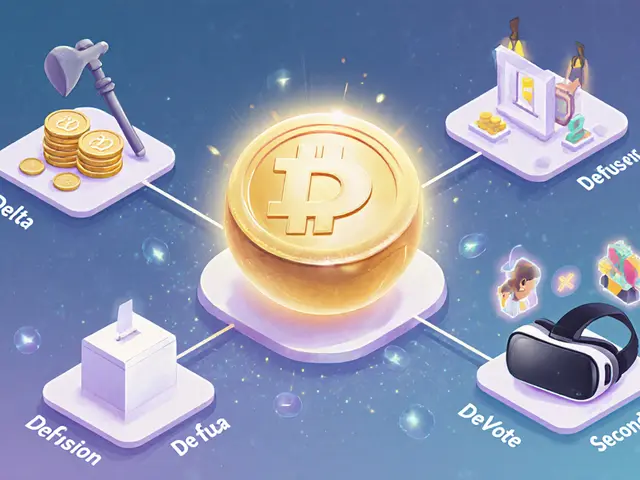Airdrop Scams: How to Spot and Avoid Crypto Fraud

Airdrop Scam Checker
Quick Take
- Never share your private key or seed phrase - legit airdrops don’t ask for them.
- Verify announcements only on official project sites or verified socials.
- Use a dedicated, low‑balance wallet for any airdrop participation.
- Avoid signing unknown smart‑contract approvals; they can drain your funds.
- If a token contains a URL in its name or description, treat it as malicious.
Crypto enthusiasts love free tokens, but that excitement fuels a wave of airdrop scams that drain wallets in seconds. This guide breaks down how the fraud works, what red flags to watch, and practical steps to keep your crypto safe.
Airdrop scam is a fraudulent token distribution scheme that pretends to be a legitimate cryptocurrency airdrop to steal assets. Scammers copy branding from popular projects like Uniswap or ApeCoin, create polished landing pages, and push the offer through Telegram bots, Discord groups, or AI‑generated deepfakes.
How Airdrop Scams Operate
Most scams follow one of three attack vectors:
- Key harvesting: A fake form asks for your private key or seed phrase under the pretense of "verification". Once entered, the attacker has full control of your wallet.
- Malicious smart‑contract signing: Users are prompted to "claim" the airdrop by signing a transaction. The contract grants the attacker unlimited spending rights, letting them empty the wallet while your keys stay hidden.
- Up‑front fees: Some campaigns demand a small payment (e.g., 0.01 ETH) to qualify. The payment address is controlled by the fraudster, and the promised tokens never arrive.
Modern scams layer these techniques with AI‑generated deepfakes of project founders or celebrity endorsements, making them look eerily authentic.
Warning Signs That Separate Scams From Legitimate Airdrops
Spotting a fake often comes down to a few tell‑tale clues:
| Red Flag (Scam) | Legitimate Indicator |
|---|---|
| Requests private key, seed phrase, or wallet password. | Never asks for key material; only requires wallet address. |
| Unverified URL with misspellings or random characters. | Official domain (e.g., uniswap.org) or verified social media handles. |
| Too‑good-to‑be‑true rewards (e.g., $10,000 worth of tokens for a single claim). | Rewards align with market caps and are disclosed in a clear tokenomics sheet. |
| Urgent language urging “instant claim” or “limited time”. | Transparent timeline with clear eligibility criteria. |
| Token name includes a URL (e.g., "http://phish.io") or suspicious characters. | Standard alphanumeric token symbols without embedded links. |
Legitimate projects also publish airdrop details on their official website, community forums, or through verified accounts on Twitter/X and Discord.

Protecting Your Wallet: Technical Safeguards
Before you even think about claiming an airdrop, secure the container that holds your crypto:
- Cryptocurrency wallet is a software or hardware tool used to store, send, and receive digital assets. Choose a reputable wallet like MetaMask for web interactions, but keep large balances in a hardware device.
- Private key is a secret alphanumeric string that authorizes transactions from a wallet. Treat it like a physical key; never type it into a website you didn’t verify.
- Prefer a Hardware wallet such as Ledger or Trezor. These devices keep your private key offline, dramatically reducing exposure to phishing sites.
- Enable two‑factor authentication (2FA) on every exchange and wallet service linked to your address.
- Set your wallet UI to hide unknown tokens. Most wallets let you toggle visibility, preventing accidental interaction with malicious contracts.
Safe Participation Practices
If you’ve verified that an airdrop is genuine, follow these steps to stay safe:
- Create a fresh, low‑balance wallet dedicated solely to airdrop claims. Load just enough ETH (or the network’s native token) to cover gas fees.
- Visit the official project site directly-type the URL yourself or use a bookmark. Avoid links from Telegram, Discord, or random Twitter posts.
- When the claim button triggers a transaction, review the contract address. Use a block explorer (Etherscan, Polygonscan, etc.) to confirm it matches the official contract posted on the project’s site.
- Reject any transaction that asks for token approvals beyond the airdrop claim. A simple "approve" for the airdrop token is fine; granting "unlimited" spending is a red flag.
- After claiming, monitor your wallet for a few days. If an unknown token appears, hide it and never interact further.
What To Do If You’ve Been Targeted
Even with caution, some users still fall prey. Here’s a quick recovery checklist:
- Immediately revoke all token approvals on Etherscan or the equivalent explorer for the compromised network.
- Transfer any remaining funds to a new, secure wallet that has never been connected to the suspect site.
- Report the scam to platforms like Twitter/X, Telegram, and the exchange you used. Include screenshots and transaction hashes.
- If a large sum was stolen, file a report with your local cybercrime unit. In Australia, contact the Australian Cyber Security Centre (ACSC).
- Educate yourself on the latest scams. Follow reputable security blogs such as Ledger Academy or the Uniswap support center.
Staying Ahead of Evolving Threats
Scam tactics evolve fast-AI‑generated deepfakes, personalized social engineering, and even compromised employee data are now common. To keep a step ahead:
- Subscribe to daily crypto news feeds from trusted outlets (CoinDesk, The Block, etc.).
- Follow project founders on verified platforms; they often announce legitimate airdrops directly.
- Use a reputable Telegram bot is a automated account that can send messages, collect data, and interact with users on the Telegram platform only if it’s officially linked from the project’s website.
- Enable wallet alerts for any token approvals or contract interactions; many wallet apps now offer push notifications.
- Participate in community “scam watch” channels where users share new phishing patterns.

Frequently Asked Questions
Do legitimate airdrops ever ask for a fee?
No. Real projects distribute tokens for free. Any request for a payment, even a small amount, is a strong indicator of a scam.
Can a hardware wallet protect me from smart‑contract phishing?
Hardware wallets keep your private key offline, but they still sign transactions you approve. If you sign a malicious contract, the attacker can move funds even though the key never left the device.
What does it mean when a token name contains a URL?
Uniswap’s support docs flag tokens with embedded URLs as malicious. They’re designed to lure users to phishing sites. Hide or ignore such tokens.
How can I verify a contract address?
Copy the address from the official project website, then paste it into a block explorer. Check the contract creator, verification status, and recent activity before approving.
Is it safe to claim airdrops on a phone wallet?
Mobile wallets are convenient but more prone to phishing via malicious apps or deep‑linked URLs. If you must use a phone, install only the official app from the app store and double‑check every transaction.
What should I do if I see an unknown token after an airdrop?
Do not click, swap, or send it. Hide the token in your wallet settings and, if possible, revoke any approvals it may have requested.







First off, always double‑check the source of an airdrop announcement before you click anything 🚀.
Look for the official project website or a verified social media handle, and avoid links posted in random Discord servers.
If something asks for a private key or a fee, that’s a red flag you shouldn’t ignore.
Using a separate low‑balance wallet for any claim can keep your main holdings safe.
Stay curious, stay safe, and feel free to share any weird offers you see for extra eyes 😊.
From a security architecture standpoint, the token‑verification pipeline you described suffers from an evident lack of cryptographic attestations, which in practice renders the entire workflow vulnerable to MITM vectors.
The reliance on UI cues alone is a textbook example of social engineering exploitation, especially when the UI is rendered via unverified third‑party scripts.
Consider integrating domain‑validated TLS certificates and multi‑factor authentication to mitigate the attack surface.
Respectfully, I’d add that keeping a clean separation between personal and airdrop wallets is a simple habit that pays dividends.
Even if the airdrop looks legit, using a fresh address means any potential breach won’t compromise your primary assets.
Also, always scan contract addresses on a block explorer before approving any transaction.
These steps are straightforward and don’t require advanced technical knowledge.
Exactly, the barrier to entry is lower when you treat every claim as a sandbox experiment.
Start with a minimal amount of gas, verify the contract creator, and you’ll spot most fake projects before they bite.
Don’t let the hype push you into hasty approvals.
Hey folks, let’s keep the momentum going by sharing a quick checklist!
1️⃣ Verify the official announcement channel.
2️⃣ Never hand over your seed phrase – it’s a non‑negotiable rule.
3️⃣ Use a hardware wallet for bigger balances, but a software wallet with a fresh address works fine for airdrops.
4️⃣ Double‑check the contract address on Etherscan.
If all looks clean, go ahead, but stay alert!
While the aforementioned checklist is commendable, it fails to address the systemic issue of decentralized project governance, which often leaves users without recourse once a fraudulent contract is deployed.
Moreover, the reliance on “official channels” presumes a level of institutional transparency that many emerging projects simply lack.
Consequently, users must adopt a more skeptical stance, questioning even seemingly verified sources.
Yo, love the vibe here! Just a heads‑up: when you’re dealing with a claim that asks for “approval for all tokens,” that’s basically a free pass for the attacker.
Make sure the approval is limited to the airdrop token ONLY.
Also, keep an eye on gas fees – sometimes scammers hide extra costs in the transaction data.
Stay safe and happy hunting!
Spot on, Chad. Adding to that, a quick glance at the transaction metadata can reveal hidden token approvals that most users overlook.
It’s also wise to set up wallet alerts for any contract interactions, so you get notified instantly if something odd pops up.
This layered vigilance makes a huge difference.
Honestly, most of these “airdrop alerts” are just noise in the signal‑to‑noise ratio of the crypto ecosystem 🤷♂️.
If you keep your private keys offline and your curiosity in check, you’ll avoid the majority of scams.
That said, the market loves hype, so expect a few deceptive campaigns to slip through the cracks.
Stay sharp, and don’t let FOMO drive your decisions 🚨.
Sounds like a typical scam.
The proliferation of airdrop schemes in the past year has exposed a fundamental weakness in the way many crypto users assess risk. Most participants rely on superficial cues such as logo design or the promise of “free tokens” without conducting a rigorous due‑diligence process. This behavioral bias is amplified by the high velocity of information flow on platforms like Telegram and Discord, where messages are often disseminated without verification. Consequently, attackers exploit the trust deficit by masquerading as legitimate projects and leveraging social proof to lure victims. A critical first step in mitigation is to establish a verifiable chain of custody for any announcement, which can be achieved by cross‑referencing the claim on the project’s official GitHub repository or its verified website. Secondly, the smart‑contract code itself should be audited or at least compared against the verified source code published on a reputable explorer. Users should also employ blockchain analytics tools that flag newly created contracts with suspicious transaction patterns. In addition, the principle of least privilege should guide every token approval, restricting permissions to the minimum necessary for the intended operation. When a dApp requests an “unlimited approval,” the rational response is to deny the request outright. Moreover, the use of a dedicated, low‑balance wallet for airdrop interactions isolates potential losses from the user’s primary holdings. Hardware wallets remain the gold standard for safeguarding private keys, but they do not eliminate the risk of signing malicious transactions. Therefore, reviewing the exact method and parameters of a signed transaction before confirming is indispensable. Education also plays a pivotal role; community‑driven “scam watch” channels have proven effective in disseminating real‑time alerts about emerging threats. By fostering a culture of shared vigilance, the community can collectively raise the cost of executing a successful scam. Finally, any user who suspects they have fallen victim should promptly revoke all token approvals via Etherscan and migrate remaining assets to a freshly generated wallet. In sum, a layered defense that combines technical safeguards, procedural discipline, and community awareness offers the most robust protection against airdrop fraud.
Great breakdown, Mark. Adding to your point about “least privilege,” I’d recommend employing the ERC‑20 “allowance” pattern with a strict expiration timestamp to further curtail abuse.
This granular control can be scripted into wallet interfaces, reducing human error.
Don’t forget to audit the token’s transferFrom logic, as many scammers embed backdoors there.
When we contemplate the allure of airdrops, we are really confronting the timeless human desire for unearned bounty, a siren song that has echoed through myth and markets alike.
The modern blockchain merely repackages that myth in code, and the same cautionary tales apply: pride precedes the fall.
By recognizing the psychological triggers-FOMO, herd mentality, and the promise of instant wealth-we can arm ourselves with mental fortitude.
Technical safeguards are essential, but the most potent defense is the disciplined mind that questions every glittering offer.
Let’s strive to be the custodians of our own digital destiny, not the unwitting pawns of opportunistic schemers.
Indeed, the cognitive bias you described aligns perfectly with the documented “risk‑seeking under uncertainty” phenomenon (Kahneman, 2011).
Implementing a personal checklist-source verification, contract audit, minimal approval-acts as a cognitive anchor that mitigates impulsive decisions.
😀 By consistently applying this framework, we transform emotional reactivity into rational protocol.
Cool points all good keep it simple verify source dont share keys
That naïve checklist is exactly why people keep losing money you need to actually read the fine print instead of spouting buzzwords.
From a global perspective, the decentralised nature of these scams reveals a lack of regulatory oversight that many Western nations ignore in favour of techno‑optimism.
European regulators, for example, have begun imposing strict AML/KYC requirements on blockchain services, which should curtail the proliferation of fraudulent airdrops.
Adopting similar frameworks worldwide would force scammers to operate in the open, reducing anonymity and protecting investors.
yeah but regulators move slow and the tech moves fast we need community tools more than govt handouts
The dance between innovation and deception in crypto is like a kaleidoscopic mural-each hue representing either brilliance or folly.
When we paint our own financial future, let’s choose the bright strokes of due diligence over the murky shadows of quick‑silver promises.